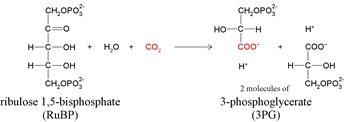Here is my question: If the heat from burning 7.800 g of C6H6 is added to 2.387 kg of water that is initially at a temperature of 21 degrees C, what is the final temperature of the water? The specific heat of liquid is 4.184 J/g*Degrees C.
-----------------------------------------------------------------------------------------------------------------------------
Data: Find: Tf: ? of the water
Benzene (C6H6) : 7.800 g
H2O : 2.387 Kg
Ti : 21.0 *C
Specific heat of water : 4.184 J/g . C
1) First we have to find the amount of heat released by the burning of 7.800 g of benzene. To find the it, we need to first write down the balanced equation for the combustion of benzene. Then use the ∆hf* of the reactants and products to find the ΔH°rxn using Hess' Law:
ΔH°rxn = Σ ΔH°f (products) - Σ ΔH°f (reactants)
2 C6H6(l) + 15 O2(g) ----> 12CO2(g) + 6H2O(g) ΔH°rxn = - 6271 K
ΔH°rxn = 12(CO2)
+ 6( H2O) – 2(C6H6) + 15(O2)
ΔH°rxn = 12(-393.5 KJ/mol) + 6 ( -241.8 KJ/ mol) – 2(49.1 KJ/ mol)
+ 15 (0 KJ/ mol) = -6271 KJ
2) Once we have the ΔH°rxn for the balanced equation of the combustion process, we can find the amount of heat released by the burning of 7.800 g of C6H6 by simply converting from grams to moles of benzene and calculating the heat produced by the burning of that many moles of reactant.
7.800 g C6H6 x
(1 mol C6H6 / 78.108 g) =
0.09986173 mol C6H6
(-6271 KJ / 2 mol C6H6 ) x 0.09986173 mol C6H6 = - 313.1165 KJ
3) Now that we know the amount of heat produced by the combustion of 7.800g of benzene, we are ready to plug in the values we were given and the heat we just found to solve for the ∆T of the water using the formula q = m x Cs x ∆T; where q is the amount of heat in J, m is the mass of the substance (water) in g, Cs is the specific heat capacity, and ∆T is the change in temperature in °C (Nivaldo J. Tro 241). Notice that q is positive because the heat is being absorbed by the water, therefore is an endothermic process.
q = m x Cs x ∆T
313116.5 J = (2387 g) x (4.184 J/ g . °C) x ∆T
313116.5
J/ (2387 g) x (4.184 J/ g . °C) = ∆T
∆T = 31.35 °C
∆T
= Tf - Ti
∆T
+ Ti = Tf
Tf = 31.35 °C + 21.0 °C = 52.35 °C






 Physical Properties:
Physical Properties: